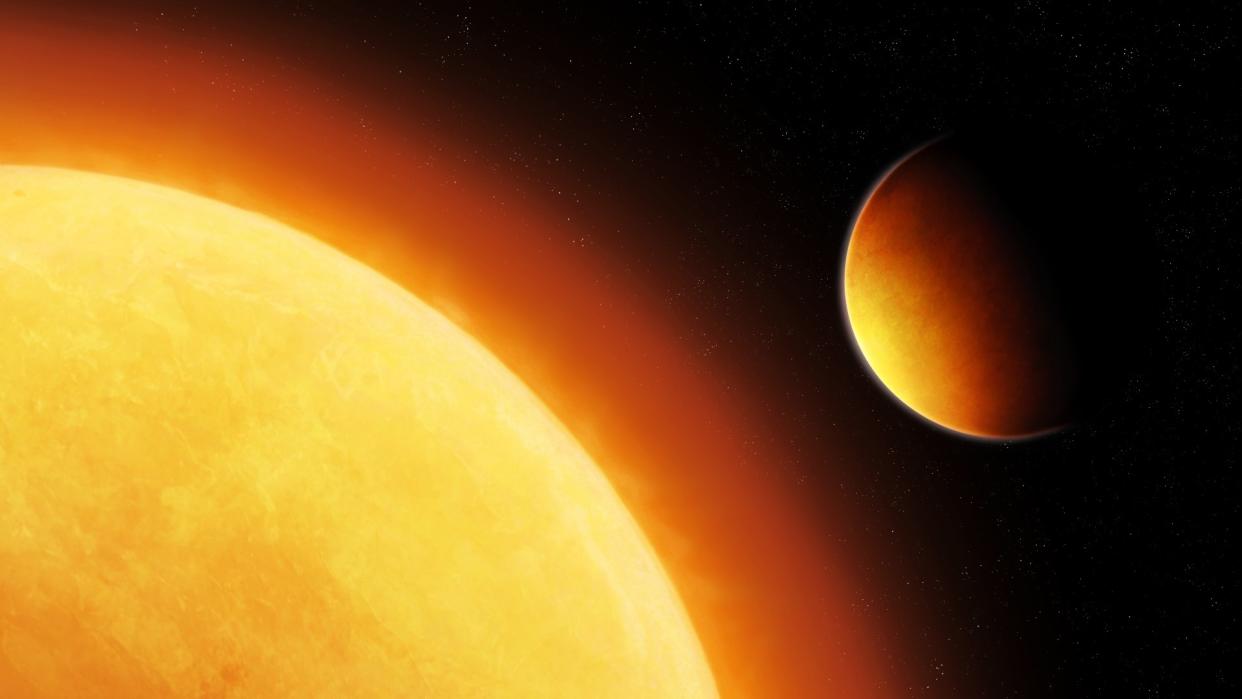Ultra-hot exoplanet has an atmosphere of vaporized rock

Heatwaves on Earth may be uncomfortable and even dangerous for some, but our planet has nothing on the blisteringly hot world of WASP-76 b.
Astronomers have taken a deeper look at the exoplanet on which temperatures soar to around 4,350 degrees Fahrenheit (2,400 degrees Celsius), hot enough to vaporize iron. In the process, the team identified 11 chemical elements in the atmosphere of the planet and measured how abundant they are.
Remarkably, some of the rock-forming elements detected on this distant planet haven't even been measured in the solar system gas giants Saturn and Jupiter yet.
"Truly rare are the times when an exoplanet hundreds of light years away can teach us something that would otherwise likely be impossible to know about our own solar system," team leader and Université de Montréal Trottier Institute for Research on Exoplanets Ph.D. Stefan Pelletier said in a statement. "This is the case with this study."
Related: 4 elusive 'mini-Neptune' exoplanets discovered in a cosmic game of hide-and-seek
Located around 634 light-years away in the Pisces constellation, the strange planet of WASP-76 b gets its incredible temperatures from its proximity to its parent star. Classified as an "ultra-hot Jupiter," which is a massive planet that exists incredibly close to its star, the exoplanet is a twelfth of the distance from its star, WASP-76, than Mercury is to the sun.
This gives WASP-76 b, which takes 1.8 Earth days to orbit its star, some other extraordinary properties. Though the planet has just around 85% of the mass of Jupiter, it is almost twice the width of the solar system gas giant and is around six times its volume. That is the result of intense radiation from its star "puffing out" the planet.
WASP-76 b has been the subject of intense study since it was found as part of the Wide Angle Search for Planets (WASP) program in 2013. This has led to the classification of several elements in its atmosphere. Most strikingly was the discovery in 2020 that iron vaporized on the side of the tidal-locked planet that permanently faces its star blows to the relatively cooler "night side" that perpetually faces space and condenses, falling as iron rain.
Spurred on by these previous investigations of WASP-76 b, Pelletier was inspired to obtain new observations of WASP-76 b with the MAROON-X high-resolution optical spectrograph on the Gemini North 8-meter Telescope in Hawaii, part of the International Gemini Observatory. This allowed the team to study the composition of the ultra hot Jupiter in unprecedented detail.
Because of the incredible temperatures of WASP-76 b, elements that would usually form rocks on terrestrial planets like Earth, such as magnesium and iron, are instead vaporized and lurk as gasses in the planet's upper atmosphere.

That means studying this world can give astronomers an unparalleled insight into the presence and abundance of rock-forming elements in the atmosphere of giant planets. This isn't possible for colder giant planets like Jupiter as these elements dwell lower in the atmosphere, making them impossible to detect.
What Pelletier and colleagues discovered during their investigation of WASP-76 b was that the abundance of elements like manganese, chromium, magnesium, vanadium, barium, and calcium match closely, not only the abundances of these elements in its own star but also the quantities found in the sun.
The elementary abundances seen aren't arbitrary; they are the result of the processing of hydrogen and helium by successive generations of stars over billions of years. A star creates heavier elements until it exhausts its fuel for nuclear fusion, dying in a supernova explosion. This blast releases those elements into the cosmos, and they become the building blocks of the next stars, with the remaining material surrounding these infant stars as proto-planetary disks, which, as the name suggests, can spawn planets. This means stars of similar ages have similar compositions with the same abundances of elements heavier than hydrogen and helium, which astronomers call "metals."
Because terrestrial planets such as ours form by more complex processes, however, they have different abundances of heavy elements than their stars. The fact that this new study shows WASP-76 b has a similar composition to its star means its composition is also similar to the protoplanetary disk of material that collapsed to birth it. And this could be true of all giant planets.

Not everything discovered about the composition of WASP-76 b was so expected, however. The team discovered that certain elements in the atmosphere of Wasp-76 b appeared to be "depleted."
"These elements that appear to be missing in WASP-76 b's atmosphere are precisely those that require higher temperatures to vaporize, like titanium and aluminum, " Pelletier said. "Meanwhile, the ones that matched our predictions, like manganese, vanadium, or calcium, all vaporize at slightly lower temperatures."
The team interpreted this depletion as indicative of the composition of the upper atmosphere of gas giant planets being sensitive to temperature. Depending on the temperature at which an element condenses, it will either be present as a gas in the upper atmosphere or missing because it has condensed to liquid and sank to lower layers. From lower in the atmosphere, the element can't absorb light making its characteristic "fingerprint" missing in observations.
"If confirmed, this finding would mean that two giant exoplanets that have slightly different temperatures from one another could have very different atmospheres," Pelletier explained. "Kind of like two pots of water, one at -1°C that is frozen, and one that is at +1°C that is liquid. For example, calcium is observed on WASP-76 b, but it may not be on a slightly colder planet."
The team made another important discovery about the atmosphere of WASP-76 b; it contains a chemical compound called vanadium oxide. The first time this compound has been spotted in the atmosphere of a planet outside the solar system. The discovery will be of great interest to astronomers because vanadium oxide can have a big impact on hot giant planets.
"This molecule plays a similar role to ozone in Earth's atmosphere: it is extremely efficient at heating up the upper atmosphere," Pelletier explained. "This causes the temperatures to increase as a function of altitude, instead of decreasing as is typically seen on colder planets."
RELATED STORIES:
— Friendless 'hot Jupiter' exoplanets may not be so lonely after all
— James Webb Space Telescope finds water in super-hot exoplanet's atmosphere
— New 'warm Jupiter' exoplanet has a weird orbit and another planet may be to blame
The team also found a higher abundance of nickel than expected around WASP-76 b, which could imply that at some point in its history, the gas giant planet swallowed a smaller terrestrial world similar to Mercury that was rich with the element.
The astronomers behind these revelations will continue to study this exoplanet and other similar worlds, attempting to discover how temperatures affect the composition of their atmospheres. As they do this, the team said it hopes that some of the things they learn can be applied to giant planets closer to home.
The research is described in a paper published on Wednesday (June 14) in the journal Nature.
